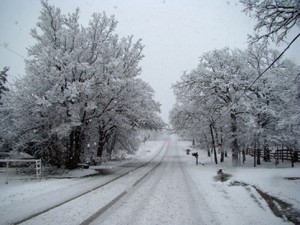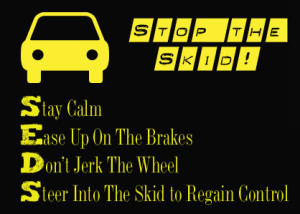Are You Ready for Winter? Part 4- Icy Driving Conditions With Horses In Tow
By Megan Arszman
Winter driving is no joke. Unless you’re lucky enough to live where the days are always sunny, then you know how just one slip can ruin your day.
Winter driving without a horse trailer in tow is pretty basic—if there’s any rain, snow, or ice, just take things slow. However, if you have to haul your horse somewhere during the frozen months, extra caution should be taken when it comes to traveling. It’s not just your vehicle you have to stop but also the extra weight from the trailer and the cargo that can push you farther than expected.
Make sure you have double the normal distance between your vehicle and the one in front of you while traveling. And don’t get too comfortable just because you have four-wheel drive. Experts remind drivers that although four-wheel drive can help you get out of tricky situations, it won’t help you stop.
Allowing for extra time to get to your destination is key, and removing distractions such as cell phones will ensure you’re ready to respond to whatever might pop up on the road ahead.
Prepare Ahead of Time
Proper maintenance of your vehicle can help prevent any emergency that might leave you and your horses stranded on the side of the highway on a not-so-pleasant evening. USRider, a group that provides emergency roadside assistance for horse owners, suggests the following procedures to include in your routine for winter weather:
- Keep your towing vehicle on a regular maintenance schedule. If you’re planning a long trip, such as to the upcoming Florida Gold Coast circuit, take your truck to a trusted mechanic for a once-over, just in case.
- Check tire pressure before each and every trip. When you travel from a cold climate to a warmer climate, the air pressure in your tires will rise and vice versa when traveling from warm to cold.
- Speak with a trusted tire dealer about the possibility of adding traction tires to your towing vehicle for the winter months. Traction tires must have at least an eighth-inch tread and be labeled “Mud and Snow,” “M+S,” “All-Season,” or have a mountain/snowflake symbol.
- If your vehicle battery is more than a couple years old, have it checked before the cold really settles in. A weak battery might not start on an extremely cold morning.
USRider also recommends, when traveling long distances, try not to let the gas gauge get below the halfway mark, because you never know what road conditions you might encounter. For most states, you can dial 5-1-1 to check traffic conditions and road closures on your route.
Keep On Hand
When planning your trip, check the states on your route and their Department of Transportation websites to find out about regulations when it comes to snow chains. In some states, vehicles over the 10,000 gross vehicle weight rating must carry chains from November 1st through March 31st. This could include vehicles towing trailers, RVs, SUVs, and some passenger trucks.
Have a car/truck emergency kit packed in your towing vehicle or trailer. The kit should include a shovel, sand or cat litter, red flags to alert passing drivers, a candle, matches or a lighter, bottles of water, and blankets. A few non-perishable snacks, a hand operated crank flashlight, and one of the new external cell phone battery packs wouldn’t hurt as well! Once the weather begins to turn, you should also keep a winter care kit complete with de-icer, an ice scraper, and extra windshield wiper fluid in your truck or trailer.
Stop the Skid
Although no one wants to get caught on an icy patch, if you do start to skid, the most important thing is not to panic. USRider advises drivers to apply brakes gently in order to reduce the chance of skidding. If you do hit a rough patch, and your tires start to spin, follow S.E.D.S.
#1- Stay calm
#2- Ease up on the brakes
#3- Don’t jerk the wheel
#4- Steer into the skid to regain control












